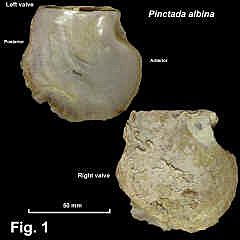|
|
MARGARITIDAE |
|
|
|
Pinctada albina (Lamarck, 1819) Description: Shape Shell with left valve more inflated than right; umbo near anterior end of dorsal margin; dorsal margin straight, anterior margin with deep byssal notch in right valve, posterior margin convex to concave, ventral margin rounded. Hinge line straight, ligament in a broad triangular pit behind umbo. Interior nacreous with a wide non-nacreous margin which is not radially striped; single large muscle scar centrally placed. Exterior smooth, initially, developing concentric overlapping laminae marginally, sometimes with finger-like processes. Shell colour fawn or grey, sometimes with darker faint radial rays; finger-like processes never banded. Size: Up to 110 mm in length. Distribution: Western Pacific, including Philippines, China, Korea, Vietnam, Indonesia, Micronesia and northern Australia. In Australia, from Perth, WA, around northern Australia, and southwards to Sydney, NSW. Habitat: Lives in shallow water (down to at least 22 m according to Hynd (1954)) attached by a byssus to solid objects on seagrass flats and reefs. Comparison: Genetic analysis of the pearl oysters in eastern Australia (Colgan & Ponder, 2002) showed that Pinctada fucata and P. albina are very similar. They said “No consistent differences between the species were apparent in shell shape, colour, periostracal characters, sculpture, hinge, adductor scar or other characters.” Regardless, the Australia Museum collection has a group of light coloured mainly unpatterned shells sorted as P. albina, on which this description is based. A difference between P. fucata and P. albina that was not reported by Colgan & Ponder (2002) is the colour of the finger-like processes on the outside of the shell. In P. fucata these are brown banded (Fig. 2 of P. fucata) but they are unbanded in P. albina. Fig. 1: Towoon Bay, NSW. Dead on rock platform. (DLB4650)
|
|
